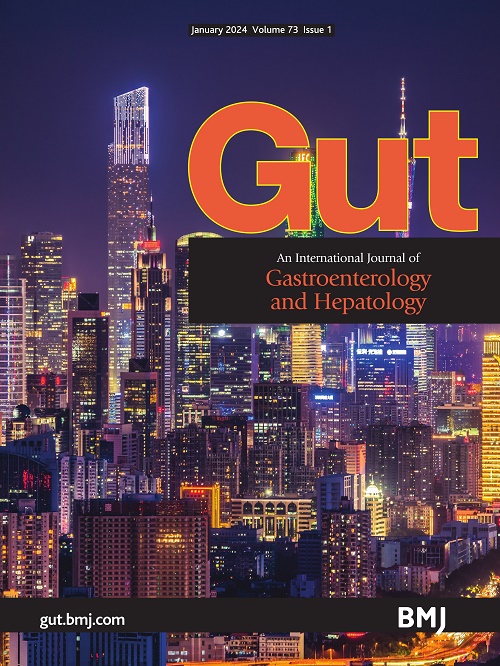Divergent lineage trajectories and genetic landscapes in human gastric intestinal metaplasia organoids associated with early neoplastic progression
IF 23
1区 医学
Q1 GASTROENTEROLOGY & HEPATOLOGY
引用次数: 0
Abstract
Background Gastric intestinal metaplasia (IM) is a precancerous stage spanning a morphological spectrum that is poorly represented by human cell line models. Objective We aim to establish and characterise human IM cell models to better understand IM progression along the cancer spectrum. Design A large human gastric IM organoid (IMO) cohort (n=28), their clonal derivatives and normal gastric organoids (n=42) for comparison were established. Comprehensive multi-omics profiling and functional characterisation were performed. Results Single-cell transcriptomes revealed IMO cells spanning a spectrum from hybrid gastric/intestinal to advanced intestinal differentiation. Their lineage trajectories connected different cycling and quiescent stem and progenitors, highlighting differences in gastric to IM transition and the potential origin of IM from STMN1 cycling isthmus stem cells. Hybrid IMOs showed impaired differentiation potential, high lineage plasticity beyond gastric or intestinal fates and reactivation of a fetal gene programme. Cell populations in gastric IM and cancer tissues were highly similar to those derived from IMOs and exhibited a fetal signature. Genomically, IMOs showed elevated mutation burden, frequent chromosome 20 gain and epigenetic deregulation of many intestinal and gastric genes. Functionally, IMOs were FGF10 independent and showed downregulated FGFR2. Several IMOs exhibited a cell-matrix adhesion independent subpopulation that displayed chromosome 20 gain but lacked key cancer driver mutations, potentially representing the earliest neoplastic precursor of IM-induced gastric cancer. Conclusions Overall, our IMO biobank captured the heterogeneous nature of IM, revealing mechanistic insights on IM pathogenesis and progression, offering an ideal platform for studying early gastric neoplastic transformation and chemoprevention. Data are available in a public, open access repository. The WES, RNAseq, scRNAseq and scCNV data were deposited into the European Genome-Phenome Archive (EGAS00001007899). RNAseq, scRNAseq and methylation data were deposited to GEO, GSE210995.与早期肿瘤进展相关的人类胃肠化生组织细胞中的不同系谱轨迹和遗传景观
背景 胃肠粘膜变性(IM)是一种癌前病变,其形态谱跨度很大,但人类细胞系模型对其表现不佳。目的 我们旨在建立人类肠化生细胞模型并确定其特征,以更好地了解肠化生在癌谱上的进展。设计 我们建立了一个大型人类胃IM类器官(IMO)队列(n=28)、其克隆衍生物和正常胃类器官(n=42)进行比较。进行了全面的多组学分析和功能表征。结果 单细胞转录组显示,IMO细胞跨越了从胃/肠混合分化到高级肠分化的范围。它们的系谱轨迹连接着不同的循环和静止干细胞及祖细胞,突出显示了胃向IMO过渡的差异,以及IMO可能起源于STMN1循环峡部干细胞。杂交 IMO 显示出分化潜能受损、超越胃或肠命运的高度系谱可塑性以及胎儿基因程序的重新激活。胃峡部干细胞和癌组织中的细胞群与来自峡部干细胞的细胞群高度相似,并表现出胎儿特征。在基因组学上,IMOs 的突变负荷增加,20 号染色体频繁增益,许多肠道和胃基因的表观遗传发生了失调。从功能上看,IMOs与FGF10无关,并显示FGFR2下调。一些 IMOs 表现出独立于细胞基质粘附的亚群,显示出 20 号染色体增益,但缺乏关键的癌症驱动基因突变,可能代表了 IM 诱导的胃癌的最早肿瘤前体。结论 总的来说,我们的 IMO 生物库捕捉到了 IM 的异质性,揭示了 IM 发病和进展的机理,为研究早期胃癌转化和化学预防提供了一个理想的平台。数据可在公开、开放的资源库中获取。WES、RNAseq、scRNAseq和scCNV数据已存入欧洲基因组-表型组档案(EGAS00001007899)。RNAseq、scRNAseq和甲基化数据已存入GEO,GSE210995。
本文章由计算机程序翻译,如有差异,请以英文原文为准。
求助全文
约1分钟内获得全文
求助全文
来源期刊

Gut
医学-胃肠肝病学
CiteScore
45.70
自引率
2.40%
发文量
284
审稿时长
1.5 months
期刊介绍:
Gut is a renowned international journal specializing in gastroenterology and hepatology, known for its high-quality clinical research covering the alimentary tract, liver, biliary tree, and pancreas. It offers authoritative and current coverage across all aspects of gastroenterology and hepatology, featuring articles on emerging disease mechanisms and innovative diagnostic and therapeutic approaches authored by leading experts.
As the flagship journal of BMJ's gastroenterology portfolio, Gut is accompanied by two companion journals: Frontline Gastroenterology, focusing on education and practice-oriented papers, and BMJ Open Gastroenterology for open access original research.
 求助内容:
求助内容: 应助结果提醒方式:
应助结果提醒方式:


